**
For me, the day before Katrina is the anniversary that always brings a moment’s silent remembrance and reassessment. It was on Sunday that we finished boarding up our house, packed our cars, and drove away from a neighborhood, a city, a life that would never be the same again. It was on Sunday when, trapped in traffic as the feeder bands of the hurricane rolled over us, I looked out over a vista of tens of thousands fleeing for their lives and realized three things with sudden, painful clarity: that I was part of an event that was both frightening and powerfully historic, that my world was about to be turned upside down and inside out, and that I was one of the lucky ones because I was getting out with my family.
It sounds like a selfish focus, concentrated on my own pain, my own experience rather than on the 1,800+ who died. It is not.
I actually started this blog on an earlier Katrina anniversary, when—like the parents of a newborn child—we were still counting the passage of time by months. Curious about how far I’ve come since that day, I went back and reread my first posting, written in my gutted office when we were still working so hard to get back into our house. Here it is…
Saturday was an anniversary of sorts. Eight months ago yesterday, Hurricane Katrina took off the roof of our New Orleans-area house while the floodwaters of Lake Pontchartrain came sluicing through the ground floor. Sometimes I still lay awake at night and torture myself with conjured images of water lapping at my bookcases…swirling around my daughter’s lovely old iron frame piano…leaching the color from the polished wood of ancient chests. The images are always without sound, like glimpses into the eerie, flooded world of Atlantis or the Titanic. And then I think, No, not my house. Reality tilts and never quite rights itself.
Eight months. For eight months we’ve lived the life of refugees, shuttling from one shelter to the next. The possessions Katrina left us are boxed and scattered—at a friend’s house in Baton Rouge and two storage units in two different cities, at my mother’s house and the now-empty house of an aged aunt for whom the horrors of Katrina proved simply too much to bear. My mind is scattered, too. I look at the antique roses in my garden, survivors whose carefully lettered copper labels were carried away by the waters into oblivion. Once, I could have named every bush, told you its heritage and characteristics. Not now. That was another life, another reality.
Imagine a house shattered by wind and water. Now imagine hundreds of thousands of houses standing broken and empty. That is New Orleans. Imagine the army of laborers and carpenters, electricians and plumbers and roofers required to make it all right again. They’re not here. (Where would they live?) And so we either wait, or we take up tools and get to work. With hammer and wrecking bar, we attack sodden walls and mold-covered doorframes. We choke back tears as we drag beloved memories, the pieces of our lives, out to the curb and abandon them there to the sun and the rain. We learn to hang and float Sheetrock, to stomp ceilings, to cut trim and plumb sinks. There is a sense of pride, a strength that comes from rebuilding our own house. I think of my ancestors braving the terrors of immigrant ships to build log cabins in the dark forests of Virginia and Tennessee. Or my other great-grandparents, the ones who belonged to the Clan of the Wolf and lived in tune with the seasons and the pulses of the earth. I wonder if they would be ashamed of me, see me as weak. Crushed and disoriented by one little hurricane. Okay, one big hurricane.
Will we ever be the same again? No. Is that a good thing, or bad? Perhaps it is both. In all these months, I have written little. The people in New York have been understanding, in their way. I put the manuscript for my next book, When Gods Die, in the mail a week before Katrina hit. My editor didn’t bother me with the revisions until January. Perhaps she realized I couldn’t handle it until then. I’m still amazed I did manage to do the revisions. I am now committed to write the next book in the series, Why Mermaids Sing. Once, I was excited about this book. I’m still excited about this book. But doubts crowd in on me. My husband says, You’ve always been like this when you start a book.
Yes, I was. But my books come from my soul, and my soul has shifted.
Saturday, August 29, 2009
Wednesday, August 26, 2009
Are You Visual or Aural?
Can the way we like to learn also influence the way we write and the kinds of books we like to read?
This interesting concept was suggested to me by Sabrina Jeffries, a NYT bestselling romance writer who recently visited our Monday night writers group (she was in town visiting her agent and critique partner of many years, both of whom are members of the group). She said she was an aural learner, and she thought that’s why she didn’t like putting a lot of visual description in her books and becomes inpatient with writers who do. (She also said where she picked up this interesting concept, but I was so focused on the idea itself that I didn’t hear that part.)
It’s an intriguing idea. I Googled learning styles and discovered that, yes, our preferred learning styles do influence more than just they way we prefer to study. They also affect the way we internally represent experiences, the way we recall information and the words we choose. So it makes sense that they would influence the way we write and whether or not we like James Lee Burke.
There are actually several different approaches to learning:
Visual (spatial): prefers using pictures, images, and spatial understanding.
Aural (auditory-musical): prefers using sound and music.
Verbal (linguistic): prefers using words, both in speech and writing.
Physical (kinesthetic): prefers using body and sense of touch.
Logical (mathematical): prefers using logic, reasoning and systems.
Social (interpersonal): prefers to learn in groups or with other people.
Solitary (intrapersonal): prefers to work alone and use self-study.
Although we usually have a dominant learning technique, most people use a combination of these approaches. The same person can even use different styles in different situations. My kids, for instance, learned better when they could move around (works great for memorizing spelling words at home, but not so good in a classroom situation when everyone is expected to sit down). My daughter also discovered she could remember her French vocab words if she wrote them on colored cards: blue for masculine nouns, pink for feminine. But our styles are not fixed; we can develop our abilities in our less dominant styles. And each of these styles uses a different part of the brain, so the more areas of the brain we use when learning, the better we remember.
I guess my exercise with the colored note cards shows that I’m very visual. My card system also betrays that I’m very logical; I like to diagram things out and classify information. But I’m also highly aural: I remember material I hear in a lecture better than I remember what I read, just as I learn the words of songs or poems I hear very quickly. Unfortunately, I am not at all kinesthetic; when my girls and I were taking Tae Kwan Do, they’d learn our belt pattern the first night and then spend the next three months trying to drill it into my thick head. I’m also a solitary rather than a social learner: no study groups for me.
How about you? How do you think your personal learning style influences your writing or reading?
This interesting concept was suggested to me by Sabrina Jeffries, a NYT bestselling romance writer who recently visited our Monday night writers group (she was in town visiting her agent and critique partner of many years, both of whom are members of the group). She said she was an aural learner, and she thought that’s why she didn’t like putting a lot of visual description in her books and becomes inpatient with writers who do. (She also said where she picked up this interesting concept, but I was so focused on the idea itself that I didn’t hear that part.)
It’s an intriguing idea. I Googled learning styles and discovered that, yes, our preferred learning styles do influence more than just they way we prefer to study. They also affect the way we internally represent experiences, the way we recall information and the words we choose. So it makes sense that they would influence the way we write and whether or not we like James Lee Burke.
There are actually several different approaches to learning:
Visual (spatial): prefers using pictures, images, and spatial understanding.
Aural (auditory-musical): prefers using sound and music.
Verbal (linguistic): prefers using words, both in speech and writing.
Physical (kinesthetic): prefers using body and sense of touch.
Logical (mathematical): prefers using logic, reasoning and systems.
Social (interpersonal): prefers to learn in groups or with other people.
Solitary (intrapersonal): prefers to work alone and use self-study.
Although we usually have a dominant learning technique, most people use a combination of these approaches. The same person can even use different styles in different situations. My kids, for instance, learned better when they could move around (works great for memorizing spelling words at home, but not so good in a classroom situation when everyone is expected to sit down). My daughter also discovered she could remember her French vocab words if she wrote them on colored cards: blue for masculine nouns, pink for feminine. But our styles are not fixed; we can develop our abilities in our less dominant styles. And each of these styles uses a different part of the brain, so the more areas of the brain we use when learning, the better we remember.
I guess my exercise with the colored note cards shows that I’m very visual. My card system also betrays that I’m very logical; I like to diagram things out and classify information. But I’m also highly aural: I remember material I hear in a lecture better than I remember what I read, just as I learn the words of songs or poems I hear very quickly. Unfortunately, I am not at all kinesthetic; when my girls and I were taking Tae Kwan Do, they’d learn our belt pattern the first night and then spend the next three months trying to drill it into my thick head. I’m also a solitary rather than a social learner: no study groups for me.
How about you? How do you think your personal learning style influences your writing or reading?
Sunday, August 23, 2009
Confessions of a Plotter
Whenever anyone asks if I plot my books in advance or simply fly off into the misty unknown and write by the seat of my pants, I always say, “Oh, I’m definitely a plotter.”
But that doesn’t mean I have every scene nailed down before I start writing. I do carefully work out the beginning and sketch in the end (the operative word there is sketch). But my ideas for the middle are usually just that—ideas for scenes that sort of float, well, in the mist. And there usually aren’t enough of them. I’ve learned over the years that my grasp of the story changes once I actually start writing and new ideas pop up, so it’s a waste of time to put too much effort up front into carefully laying down a path I won’t end up following.
But I can only go on like that for so long. Somewhere around page 75-100, I haul out my 3x5” cards and go to work on my plot again. Each card represents one scene. The note cards I use at the initial concept stage—when I’m just getting a rough idea of what will happen for the proposal—are all white. But once I’m well into writing the story, I get really obsessive about pacing and timing. And since I’m a visual kind of person, when I go back and attack my plot again I use colored index cards.
If you’re curious about what all those different colors mean, here’s the code for my thrillers (I take a different approach for my mysteries):
Light green: Tobie and Jax scenes
Light blue: Noah scenes (Noah is the protagonist of the interwoven subplot)
Purple: action scenes involving Tobie and Jax (i.e., chases, fights, shootouts, etc.)
Dark blue: action scenes involving Noah
Dark red: the head villains plotting the dastardly deed Jax and Tobie are racing to avert
Light red: the villains’ minions, maneuvering to get Jax and Tobie (or Noah)
Yellow: missing links—places I need something to get me into or out of a scene or sequence of scenes
The beauty of this system is that I can see everything—pacing, character flow, and missing links—at a glance. I can see I need a purple card (a fight or a chase) here, or that I go too long without a villain scene there, or that I need another blue sequence with my subplot character, Noah, in there.
The layout is significant, too. But for now, I’ll leave you snickering at my OCPD tendencies.
Wednesday, August 19, 2009
Back on Track
Well, I finally finished the reworking of the first hundred and twenty pages of The Babylonian Codex. I sat down last night and read through it. The pacing is good and the action tight, so all systems are now go to chug forward again.
I had a brief moment of panic when I couldn’t find my outline for the rest of the book. That outline—much scribbled over after Steve and I spent several nights intensively replotting—still isn’t finished, but the thought of losing the progress we’d made had me sick to my stomach. I spent several frantic hours cleaning up my office and my bedroom (I do a lot of my writing perched on the porch swing of the upstairs gallery). On the off chance I'd somehow mixed it up with my research material, I even sorted through and filed a huge stack of notes and print outs on everything from sailboats to the Gospel of St. Thomas (at which point I realized I’ve done way too much research for this book). I even went through the trash. And still no luck.
Of course I found it sitting on my desk, stuffed in the back of a note pad but so well aligned that nary a hint of its presence showed. I swear I looked in that pad a dozen times.
Note to self: become more organized, or risk stroke.
I had a brief moment of panic when I couldn’t find my outline for the rest of the book. That outline—much scribbled over after Steve and I spent several nights intensively replotting—still isn’t finished, but the thought of losing the progress we’d made had me sick to my stomach. I spent several frantic hours cleaning up my office and my bedroom (I do a lot of my writing perched on the porch swing of the upstairs gallery). On the off chance I'd somehow mixed it up with my research material, I even sorted through and filed a huge stack of notes and print outs on everything from sailboats to the Gospel of St. Thomas (at which point I realized I’ve done way too much research for this book). I even went through the trash. And still no luck.
Of course I found it sitting on my desk, stuffed in the back of a note pad but so well aligned that nary a hint of its presence showed. I swear I looked in that pad a dozen times.
Note to self: become more organized, or risk stroke.
Sunday, August 16, 2009
Just Cats
I'm still struggling with the rewrite of the first third of my book, so I thought I'd do an update on our new foundling and her babies.
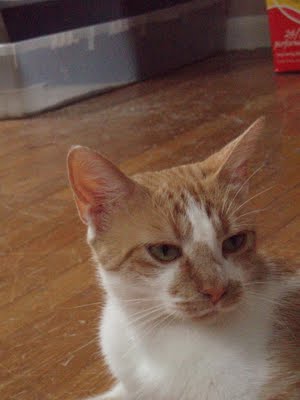
Mama is slowly gaining weight--not an easy task while also feeding four hungry little ones.
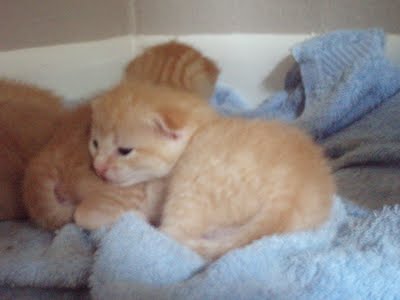
The kittens all have their eyes open and are getting huge.
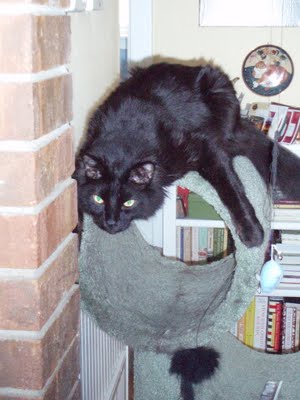
Here's a picture of big bad Huckleberry, being silly.
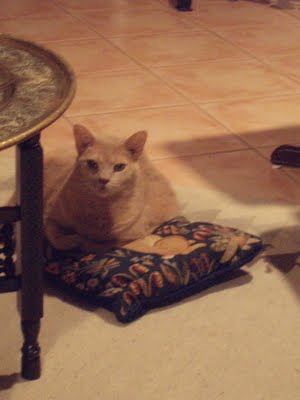
And here is a photo of my little sweetheart, Press Cat, that I found on the camera and didn't even know I had.
Mama is slowly gaining weight--not an easy task while also feeding four hungry little ones.
The kittens all have their eyes open and are getting huge.
Here's a picture of big bad Huckleberry, being silly.
And here is a photo of my little sweetheart, Press Cat, that I found on the camera and didn't even know I had.
Thursday, August 13, 2009
The 100-Page Hiccup on Steroids
I always throw a fit just about the time I hit the 100-page mark on a new manuscript. I’ve even developed a name for it: the Hundred Page Hiccup. At that point I have the story established and the characters introduced and enough pages written that I can get a feel for how the story is shaping up. I go back, do some line editing, print out a clean copy, and sit down to read. And I always, always freak out.
This book is sh*t!! It’s too slow! The idea sucks! What’s wrong? I don’t know how to fix it! Oh my God, my career is ruined!
That’s exactly what happened to me last week when I sat down to read the first 100 pages of The Babylonian Codex, my next remote viewing thriller. Oh, I was happy enough with the first fifty pages or so. Then the story turned into a wet noodle. Since I’m already far, far behind on my schedule, I had a panic attack. Steve said, “Give it to me; I’ll read it.” So he read it, handed it back, and said, “I think it’s good.” I wanted to believe him. But in my heart of hearts, I knew he was wrong.
I headed up to the lake house anyway, planning to spend a few days of intensive writing. I am sooo far behind schedule it’s not even funny, so I really, really needed to tear out at least 75 pages. But before I buckled down to write, I decided to reread. And perhaps thanks to the extra oxygen in the air up there and the super quiet, light bulbs started popping in my head. I sent Steve a text message at 1:30 am that read, “I know what’s wrong with this book!” (Of course he was asleep.)
So what was wrong? So much that it deserves its own post. Suffice it to say that I spent virtually my entire time at the lake figuring out how to fix it (knowing what’s wrong and knowing how to fix it are two very different things). I only managed to write about 20 pages of new scenes to insert, and my reorganization and rethink ended up massively requiring me to rewrite the last 50 pages (I'm still working on that) and completely cut three entire scenes that added up to 16 pages. When you’re already way behind schedule, that’s a killer. But it was necessary.
Is the book better now? I don't know. Once I've finished this planned overhaul, I'll sit down and read it again. God help me.
This book is sh*t!! It’s too slow! The idea sucks! What’s wrong? I don’t know how to fix it! Oh my God, my career is ruined!
That’s exactly what happened to me last week when I sat down to read the first 100 pages of The Babylonian Codex, my next remote viewing thriller. Oh, I was happy enough with the first fifty pages or so. Then the story turned into a wet noodle. Since I’m already far, far behind on my schedule, I had a panic attack. Steve said, “Give it to me; I’ll read it.” So he read it, handed it back, and said, “I think it’s good.” I wanted to believe him. But in my heart of hearts, I knew he was wrong.
I headed up to the lake house anyway, planning to spend a few days of intensive writing. I am sooo far behind schedule it’s not even funny, so I really, really needed to tear out at least 75 pages. But before I buckled down to write, I decided to reread. And perhaps thanks to the extra oxygen in the air up there and the super quiet, light bulbs started popping in my head. I sent Steve a text message at 1:30 am that read, “I know what’s wrong with this book!” (Of course he was asleep.)
So what was wrong? So much that it deserves its own post. Suffice it to say that I spent virtually my entire time at the lake figuring out how to fix it (knowing what’s wrong and knowing how to fix it are two very different things). I only managed to write about 20 pages of new scenes to insert, and my reorganization and rethink ended up massively requiring me to rewrite the last 50 pages (I'm still working on that) and completely cut three entire scenes that added up to 16 pages. When you’re already way behind schedule, that’s a killer. But it was necessary.
Is the book better now? I don't know. Once I've finished this planned overhaul, I'll sit down and read it again. God help me.
Saturday, August 08, 2009
Bon Temps
**
Steve and I first fell in love with the charming town of Clinton, Louisiana, some six years ago, when we stumbled upon it by chance while exploring the gently rolling hills of what are known as the Felicianas. With its moss-draped live oaks, stately columned courthouse, Victorian-era false-fronted shops, and graceful antebellum homes, Clinton is a picture book-style old Southern town. After Katrina, when we decided to buy a “bolt hole” that we could use for future hurricane evacuations, it seemed somehow inevitable that we ended up buying a house on a small lake on the outskirts of Clinton.
So it was a bit of a kick to drive through town on our way to the lake a few weeks ago and discover that Clinton had been turned into the physical manifestation of Bon Temps, the fictional small Louisiana town that serves as the setting for the HBO series “True Blood.”
**
Personally, I’ve never seen “True Blood,” although I have read one of the Sookie Stackhouse books. The filming of the location shots was evidently quite an experience for the cast, who had to deal with real heat and humidity rather then simply pretending they were dealing with heat and humidity.
“It makes you move slower, which is interesting for character,” said actor Stephen Moyer. “I understand now why people move so slow down here.” To which Anna Paquin, who plays Sookie, chimed in, “You have to move slower, or you’ll pass out!”
Seems Clinton will be appearing in three of the upcoming episodes, including the August 23rd episode and the season finale. And given the series’s success, more filming will likely be scheduled in the future. Which is nice to know, because like so many small American towns these days, Clinton needs all the help it can get.
**
Steve and I first fell in love with the charming town of Clinton, Louisiana, some six years ago, when we stumbled upon it by chance while exploring the gently rolling hills of what are known as the Felicianas. With its moss-draped live oaks, stately columned courthouse, Victorian-era false-fronted shops, and graceful antebellum homes, Clinton is a picture book-style old Southern town. After Katrina, when we decided to buy a “bolt hole” that we could use for future hurricane evacuations, it seemed somehow inevitable that we ended up buying a house on a small lake on the outskirts of Clinton.
So it was a bit of a kick to drive through town on our way to the lake a few weeks ago and discover that Clinton had been turned into the physical manifestation of Bon Temps, the fictional small Louisiana town that serves as the setting for the HBO series “True Blood.”
**
Personally, I’ve never seen “True Blood,” although I have read one of the Sookie Stackhouse books. The filming of the location shots was evidently quite an experience for the cast, who had to deal with real heat and humidity rather then simply pretending they were dealing with heat and humidity.
“It makes you move slower, which is interesting for character,” said actor Stephen Moyer. “I understand now why people move so slow down here.” To which Anna Paquin, who plays Sookie, chimed in, “You have to move slower, or you’ll pass out!”
Seems Clinton will be appearing in three of the upcoming episodes, including the August 23rd episode and the season finale. And given the series’s success, more filming will likely be scheduled in the future. Which is nice to know, because like so many small American towns these days, Clinton needs all the help it can get.
**
Tuesday, August 04, 2009
7+5=12
One of my daughters went up to a national park in Arkansas for a quick break before school starts, and called me on the way home to say, “There was this sweet little orange cat that someone had dumped in the park. The rangers said all the area shelters are full, and she was so skinny she’d have died if I hadn’t taken her. You aren’t mad, are you?”
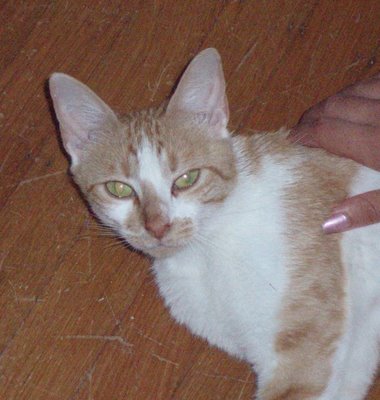
“No. I understand.”
“Well, the thing is, you see, she was skinny everywhere except her belly.”
Deep breath. “You mean she’s going to have kittens?”
“Um… She kinda had them. In the backseat of the car when we were on the Interstate.”
So this family that already had waaaay too many cats now has five more.
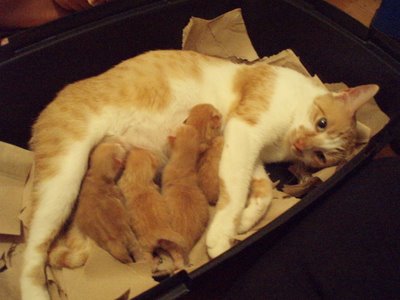
She is an unbelievable little sweetheart. Mom and kids are doing great. The vet says that even though she is pathetically skinny she is healthy, and she ought to be able to feed them.
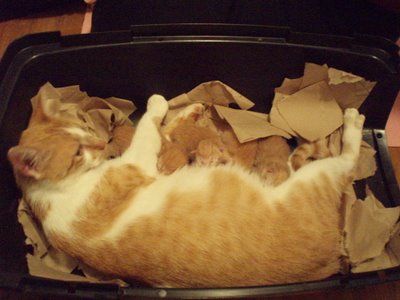
Know anyone who wants a kitten?
“No. I understand.”
“Well, the thing is, you see, she was skinny everywhere except her belly.”
Deep breath. “You mean she’s going to have kittens?”
“Um… She kinda had them. In the backseat of the car when we were on the Interstate.”
So this family that already had waaaay too many cats now has five more.
She is an unbelievable little sweetheart. Mom and kids are doing great. The vet says that even though she is pathetically skinny she is healthy, and she ought to be able to feed them.
Know anyone who wants a kitten?
Subscribe to:
Posts (Atom)



